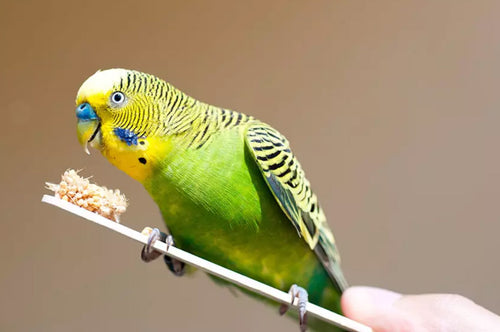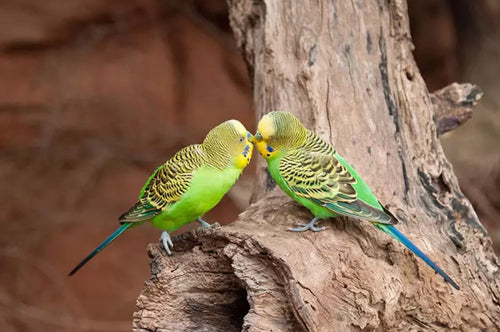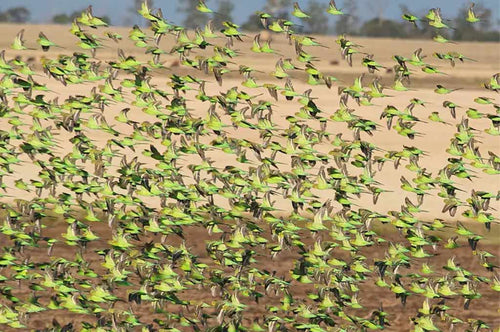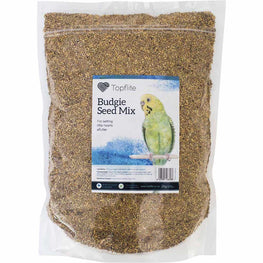Budgies | The World's Most Popular Pet Bird
Originating from Australia, there are more budgies in the world than any other type of pet bird. People have loved them from the moment they were introduced into European bird collections in the 1840s. And if there’s one thing that’s propelled them to the top slot, it’s the budgies sheer personality. They’re small but full of character, cramming all the charisma of a parrot into a package not much bigger than a canary.
Equally important from an owner’s point of view, budgies are relatively easy to keep. As long as you look after the basics - regular feeding, weekly cleaning and affectionate attention to the basic needs of this intelligent, sociable animal, your budgies will practically look after themselves.
Budgies are both undemanding and very intelligent. It's a rare combination as you often have to trade one asset for the other when choosing a pet! Bursting with life and with a constant musical chatter (and the occasional squawk), they will soon take centre stage in your home; and with a bit of care and patience you'll have them feeding from your hand and using you as a favourite perch on their indoor adventures outside the cage.


Keeping budgies can be taken to another level, with many enthusiasts involved in breeding the birds, looking after chicks, specialising in particular varieties, getting them ready for budgerigar shows, and keeping an outdoor aviary rather than an indoor cage. Budgie keeping can become an engrossing and satisfying hobby and you'll be joining a world already full of budgie fans, eager to share tips and expertise both online and in person. If you don't want to take it this far, you can still set yourself - and your bird - satisfying challenges like teaching them to talk, which is great fun and requires no additional outlay, just time and patience...
Budgerigar | the Meaning

Budgie is shortened from Budgerigar, a native Australian name 'Betcherrygah'. The betcherry bit means ‘good’, and gah means ‘parakeet’. There is some disagreement over the precise nuance of the ‘good’ part – it may mean ‘good to look at/handsome’; it may be ‘good’ because a flock of budgies indicates a good water supply (a useful guide for native Australians); or it may refer to the birds as an early aboriginal food source.
The slight confusion over the meaning of ‘budgerigar’ is increased further by the theory that the native word betcherrygah is onomatopoeic - i.e. it imitates the bird’s twittering voice.
The word 'budgery' (without the ‘gar’), sometimes written as 'boojery', is an obsolete Australian English slang word, used in the same way as those largely meaningless but positive exclamations ‘Great!’, ‘Excellent!’ or ‘Awesome!’
Budgerigar | the Name

What’s in a name? Quite a lot when it comes to budgies. The bird’s scientific tag is Melopsittacus undulates, the first bit meaning ‘melodious parrot’, and the second referring to the undulating flight of a budgie flock. Whilst known more formally as budgerigars, the USA often refers to them as the common pet parakeet, parakeet budgerigar, plain ‘parakeet’ or the shortened form ‘keet’. This can be confusing elsewhere in the world where the word ‘parakeet’ applies to various species of small to medium-sized parrots, but not budgies. In Australia, birds bred from wild stock are called shell parakeets, to differentiate them from their captive-bred cousins.

A millet stick is a handy treat
A Brief History
After first being spotted by sailors during their epic voyage to the east coast of Australia, with Captain James Cook in 1770, sailors reported seeing flocks of small green birds in such huge numbers that they blocked out the sun. They didn’t have a name for them yet but these were undoubtedly budgerigars.
The budgie was added to the list of known species in 1805, when the British Museum natural history department’s assistant keeper George Shaw first described it for the scientific community. In 1840 the first pair was brought to England. and Queen Victoria was given a pair of budgies in 1845. Twenty years later, the bird was being imported in such quantities, it was barely sustainable. Australia, alarmed at the depletion of native stocks banned the export of budgies in 1894, by which time breeders in Europe were producing thousands of new birds. America embraced budgies in the 1920s and the budgie bug caught on in the 1950s.


Budgies in the wild
Evolutionary History
The budgie is perfectly designed for its nomadic life in the Australian outback. Like other parrots, it has very dexterous four-toed feet, which act like hands for grasping and holding objects. Its beak offers additional support to the toes, as the bird can open its mouth very wide when gripping large items. This is a budgie speciality - most birds have the upper part of the beak fused to the skull, but in the budgie and other parrots the upper beak is hinged, giving much freer movement. Inhabitants of Australia for more than five million years, budgies are members of the highly successful and widely distributed parrot family. This family has been around for at least 50 million years. Parrots are sun-lovers, confined to the southern hemisphere and Australasia has more species than any other part of the planet.

Budgies belong to the parrot family
At 18cm long (up to 24cm in some captive varieties), budgies are among the smallest members of the parrot family. Parrots are the most intelligent members of the bird family (crows come a very close second) as the part of their brain capable of learning and memorising sounds, including human speech, is very well developed. The budgie Guinness World Record holder for speech had a staggering 1,728 words in his vocabulary Budgies are also able to learn complex tricks like skateboarding or maze-cracking. This begs the question - how and why did their intelligence evolve? Constantly moving around looking for the best feeding, drinking and nesting sites while negotiating a complex and ever-shifting social structure requires the ability to adapt quickly and ‘think on your feet’. Perhaps over the millennia, the most adaptable, resourceful and intelligent birds got to pass on their genes to the next generation.




